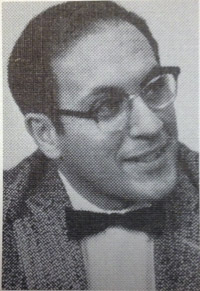Prof. Howard Saltsburg remembered
Howard Saltsburg, who helped pioneer the use of microcomputers in the undergraduate chemical engineering curriculum at the University of Rochester, is also remembered for his contributions to the fields of catalysis and surface science.
 Saltsburg, who joined the University’s Department of Chemical Engineering in 1970, died Feb. 11, 2016. After nearly 30 years with the University of Rochester, he later served as a Research Associate Professor with the Department of Chemical and Biological Engineering at Tufts University.
Saltsburg, who joined the University’s Department of Chemical Engineering in 1970, died Feb. 11, 2016. After nearly 30 years with the University of Rochester, he later served as a Research Associate Professor with the Department of Chemical and Biological Engineering at Tufts University.
Saltsburg was the first faculty member hired by the department here who did not have a chemical engineering background. He received his PhD in physical chemistry at Boston University in 1955, then did postdoctoral work at the University of Rochester with Prof. Frank P. Buff in the Department of Chemistry. He later worked with General Electric and then with Gulf General Atomic in San Diego before joining the Chemical Engineering department here.
“Saltsburg and (Prof. James) Anderson provided surface science/catalysis experience of the first time,” former department chair John Friedly notes in 75 Years of Chemical Engineering: 1915-1990.
“Howard was a great researcher and teacher,” said Evan Granite ’94, who was advised by Saltsburg on his PhD thesis here. Granite, now a research chemical engineer at the National Energy Technology Laboratory and technical coordinator for NETL’s in-house research on rare earth detection and recovery, described Saltsburg as “very brilliant and demanding. He made major contributions to the fields of catalysis and surface science.
“He will be missed.”
Starting in 1978, Saltsburg and Prof. Richard Heist, later working with Senior Technical Associate Thors Olsen and computing fellow F. William Arcuri, introduced the use of microcomputers into the undergraduate chemical engineering curriculum.
“Experiments and interfaces were redesigned where possible to permit students to collect more data in a more accurate, less tedious manner, letting them concentrate more on the technical detail of the experiment,” Friedly writes. “All this was done with relatively inexpensive Commodore microcomputers, permitting the one student-one computer concept to be a reality.”
This early, innovative use of computers in the lab drew widespread attention.
“Heist, Saltsburg and Olsen were in great demand,” Friedly notes. “A number of departments sent faculty to observe the techniques . . . National, and indeed international publicity for the department was generated.”
The coverage included a lengthy feature in Chemical and Engineering News.
At Tufts, Saltsburg was a “valuable collaborator to Prof. Flytzani-Stephanopoulos in her research on atomic-scale catalysts for fuel processing, and a co-advisor or thesis committee member for more than 10 doctoral students,” wrote Kyongbum Lee, Tuft’s Professor and Chair of Chemical and Biological Engineering, after Saltsburg retired in 2014. “This collaboration has resulted in several seminal publications that have been cited more than 2,500 times to date.”

This photo, taken in 1982, shows students working on an air-bath temperature control project in ChemE’s microcomputer lab.
